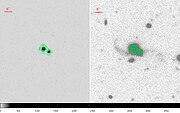noaoann10007 — Announcement
Caught in the act: a merging binary QSO
26 January 2010
It has been assumed for some time that binary supermassive black holes (SMBH) should be common in the universe, given that galaxies regularly interact and merge and that most, if not all, galaxies contain a SMBH. Such a SMBH will only be detected as a quasar when it is accreting matter. And galaxy merging is a leading proposal to trigger such accretion. Now the first luminous, spatially resolved binary quasar that clearly inhabits an interacting/merging galaxy pair has been reported. ( SDSS J1254+0846: A Binary Quasar Caught in the Act of Merging, Green et. al., Ap. J accepted Jan. 2010 ). The unique properties of this system allow detailed numerical simulations to create plausible scenarios for the histories of both the host galaxies and the SMBH that inhabit them.
The first spectrum confirming this binary QSO was taken by A. Myers at the KPNO Mayall 4-meter using R-C Spectrograph on Feb 12, 2008. Subsequent Chandra/NOAO observations (P. Green, P.I.) with the MOSAIC imager on the Mayall 4m image obtained March 18, 2009 (Barkhouse, Myers observing) revealed the existence of the tidal arms in the host galaxy,seen in the figure above. Additional deeper imaging and spectroscopy with Magellan/IMACS were used by the authors to determine the properties and history of this merger.

